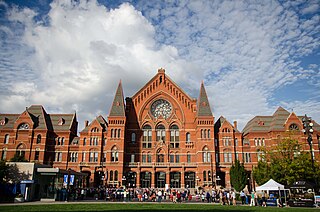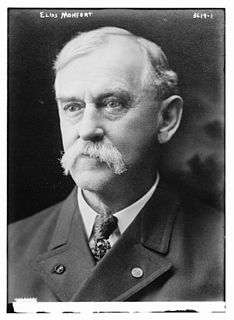
The Cincinnati May Festival is a two-week annual choral festival, held in May in Cincinnati, Ohio, US.

George Hoadly was a Democratic politician. He served as the 36th governor of Ohio.

Music Hall, commonly known as Cincinnati Music Hall, is a classical music performance hall in Cincinnati, Ohio, completed in 1878. It serves as the home for the Cincinnati Ballet, Cincinnati Symphony Orchestra, Cincinnati Opera, May Festival Chorus, and the Cincinnati Pops Orchestra. In January 1975, it was recognized as a National Historic Landmark by the U.S. Department of the Interior for its distinctive Venetian Gothic architecture. The building was designed with a dual purpose – to house musical activities in its central auditorium and industrial exhibitions in its side wings. It is located at 1241 Elm Street, across from the historic Washington Park in Over-the-Rhine, minutes from the center of the downtown area.

Daniel Drake was a pioneering American physician and prolific writer.

James Findlay was an American merchant, politician and veteran of the War of 1812, having served with both the state militia and the United States Army. He was based in Cincinnati, Ohio after migrating there as a young man. He was elected as mayor of Cincinnati to two non-successive terms.
Samuel Hannaford was an American architect based in Cincinnati, Ohio. Some of the best known landmarks in the city, such as Music Hall and City Hall, were of his design. The bulk of Hannaford's work was done locally, over 300 buildings, but his residential designs appear through New England to the Midwest and the South.
Samuel Watts Davies was an American politician.
CBRE | Heery, formerly known as Heery International, Inc., was founded in 1952 by George T. Heery and his father C. Wilmer Heery Jr., and is a full-service architecture, interior design, engineering, construction management, program management, and commissioning firm with over 500 employees located in 19 offices across the United States.

Nicholas Longworth Anderson was a United States Army officer who served in the American Civil War as Colonel of the 6th Ohio Volunteer Infantry. After the Civil War, he was nominated and confirmed for appointment to the brevet grades of brigadier general and major general of volunteers.

Hyde Park is an affluent neighborhood on the east side of Cincinnati, Ohio. The population was 13,356 at the 2010 census.

Abiel Abbot Low was an American entrepreneur, businessman, trader and philanthropist who gained most of his fortune from the China trade, importing teas, porcelains, and silk, and building and operating a fleet of reputable clipper ships.

St. Francis Hospital is a registered historic building in Cincinnati, Ohio, listed in the National Register on April 19, 1984. Opened in 1889 as St. Francis Hospital for Incurables by the Poor Sisters of St. Francis in the United States, it was initially the only hospital west of the Alleghenies with facilities to treat cancer. It operated until 1981.

James Keys Wilson was a prominent architect in Cincinnati, Ohio. He studied with Charles A. Mountain in Philadelphia and then Martin E. Thompson and James Renwick in New York, interning at Renwick's firm. Wilson worked with William Walter at the Walter and Wilson firm, before establishing his own practice in Cincinnati. He became the most noted architect in the city. His Old Main Building for Bethany College and Plum Street Temple buildings are National Historic Landmarks. His work includes many Gothic Revival architecture buildings, while the synagogue is considered Moorish Revival and Byzantine Architecture.

Albert C. Nash (1825-1890) was an American architect best known for his work in Milwaukee and Cincinnati.
Austin Eldon Knowlton was a trained architect who spent most of his career in the construction industry. His company designed, financed, and built more than 160 college and university buildings on every major college campus in Ohio and more than 200 elementary and secondary school buildings. His companies have also constructed more than 35 major hospitals and 43 United States Post Offices throughout the country. In his lifetime, he designed more than 600 buildings.
Abe Olman, born Abraham Olshewitz, was an American songwriter and music publisher. He composed a number of successful ragtime and popular songs including "Red Onion Rag" (1912), "Down Among the Sheltering Palms" (1915), "Oh Johnny, Oh Johnny, Oh!" (1917), and "Down By the O-Hi-O" (1920). He was later director of ASCAP, and a founder of the Songwriters Hall of Fame which, in 1983, named the annual Abe Olman Publisher Award in his honor.

Elias Riggs Monfort was a Union Civil War officer, attorney, the postmaster for Cincinnati, Ohio, and Commander-in-Chief of the Grand Army of the Republic from 1915 to 1916.
Robert Clarke & Company was a book publishing company and bookseller in Cincinnati, Ohio from 1858 to 1909. After 1894, it was known as The Robert Clarke Company. It published literary and historical works.

John Reily (1763-1850) was a soldier in the American Revolution who later held a number of civic positions including helping draft the Ohio State Constitution. Reily Township in Butler County, Ohio is named for him.
William Hooper was a Cincinnati businessman and politician. He was appointed state treasurer of Ohio following the resignation on September 25, 1865 of G. V. Dorsey, serving until January 1866 when S. S. Warner was sworn in.













